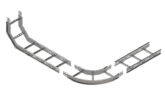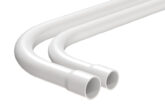
Jonathan Rawlinson, Technical Manager at Prysmian, helps clarify the rules relating to cable supports in advance of proposed changes to the Wiring Regulations.
The proposed changes to the 18th Edition includes a requirement that: ‘Wiring systems shall be supported such that they will not be liable to premature collapse in the event of a fire’ (clause 521.10.202).
This new requirement expands the current regulation which only applies to the support of cables in escape routes; under the new regulation this requirement will be extended to include the support of cables in all areas. In other words, any cable, not just those in escape routes, will need to be prevented from premature collapse.
It is a significant change, one which precludes the use of non-metallic cable clips or cable ties as the sole means of support where cables are fixed to the fabric of the building and also precludes the use of non-metallic cable trunking as the sole means of support for the cables within. In fact, the draft 18th Edition suggests that “suitably spaced steel or copper clips, saddles or ties are examples that will meet the requirements of this regulation”.
All this is very helpful, but only to a point. Where things can get confusing is that a fixing solution that meets the requirements of the Regs may not be suitable for fixing fire resistant cable for fire alarms, voice evacuation systems and emergency communication installed under BS5839-1; for emergency lighting installed according to BS5266-1; or for cable of life safety and firefighting systems in large buildings installed in accordance with BS8519.
Allow me to explain…
The changes to the Wiring Regulations have been proposed to ensure that any cable, whether for power or communication, doesn’t fall and create a hazard to occupants trying to exit a building in a fire or to fire-fighters trying to manage the fire and move around the building.
The change will require all cables not supported on metal cable trays, ladder racks or within metallic trunking to be securely fixed to the structure of the building using fixings that will not disintegrate in fire. This will require metal fixings: plastic cable ties and cable trays are not considered appropriate, neither is aluminium because of its low melting point.
Currently there is no product standard to identify appropriate fixings to comply with the Wiring Regulations. The only requirement is that the cable is retained in position – i.e. that the fixing doesn’t fail and it isn’t concerned with contributing to the ongoing performance of the cable during a fire.
Where cable supports safety-critical services, the standards place significant emphasis on the performance of the fire resistant cable, which must be able to maintain its function for up to 120 minutes. Fixings for this type of installation are critical because of their contribution to maintaining the integrity of the circuit by preventing the cable becoming stretched, kinked or damaged. It is also essential that the fixings are sized correctly, for example a fixing that is too small may crush the cable insulation, making it vulnerable in event of a fire – exactly the time at which it needs to be performing properly.
For this reason Prysmian tests its fire resistant cable and cable fixings together to ensure that together they deliver the required performance. Prysmian, for example, wouldn’t be able to recommend an installation using fixings other than those specifically designed to accompany its cables, for which it has test data. For its range of specialist fire resistant cables Prysmian Group developed its own range of fixing products – the BICON range.
The good news for those looking to comply with the proposed changes to the 18th edition is that the BICON range includes fixings that can be used to fulfil the performance requirements of the Wiring Regulations. The BICON range also includes fixings (and cable and fixing combinations) that have been specifically tested to the rigorous performance requirements of BS5839, BS5266 and BS8519.
For more information on the range of BICON fixings from Prysmian visit: www.biconcomponents.co.uk










